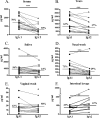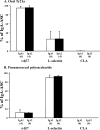Expression of homing receptors on IgA1 and IgA2 plasmablasts in blood reflects differential distribution of IgA1 and IgA2 in various body fluids
- PMID: 20089794
- PMCID: PMC2837950
- DOI: 10.1128/CVI.00475-09
Expression of homing receptors on IgA1 and IgA2 plasmablasts in blood reflects differential distribution of IgA1 and IgA2 in various body fluids
Abstract
Although secretory IgA is the most abundantly produced Ig isotype, the mechanisms underlying the differential distribution of IgA subclasses in various body fluids remain unclear. To explore these mechanisms, we examined the distribution of IgA subclasses, the influence of the nature and sites of encounters with antigens, and the correlation between IgA subclass distribution and homing potentials of circulating IgA plasmablasts. IgA1 predominated in serum, tears, nasal wash fluid, and saliva; the levels of IgA1 and IgA2 were comparable in vaginal wash fluid; and IgA2 predominated in intestinal lavage fluids. Seventy-one percent of circulating IgA plasmablasts secreted IgA1. The intestinal homing receptor (HR), alpha4beta7, was expressed more frequently on IgA2 than on IgA1 plasmablasts, with no differences in the expression of other HRs. IgA subclass distribution among circulating antigen-specific antibody-secreting cells (ASC) was dependent on the nature of the antigen: following vaccination with Salmonella enterica serovar Typhi, unconjugated pneumococcal polysaccharide, or Haemophilus influenzae polysaccharide-diphtheria toxoid conjugate, the proportions of specific IgA1 ASC were 74%, 47%, 56%, and 80%, respectively. HR expression depended on the route of administration: expression of HRs was different after oral than after parenteral vaccination, while no difference was seen between HR expression of antigen-specific IgA1 and IgA2 ASC induced via the same route. The key factors determining IgA subclass distribution in a given secretion are the nature of the antigens encountered at a particular site and the site-specific homing instructions given to lymphocytes at that site. These two factors are reflected as differences in the homing profiles of the total populations of circulating IgA1 and IgA2 plasmablasts.
Figures




Similar articles
-
Validation of IgA1 and IgA2 measurements by a solid-phase immunoradiometric assay in serum and secretions.Int J Clin Lab Res. 1994;24(3):154-61. doi: 10.1007/BF02592446. Int J Clin Lab Res. 1994. PMID: 7819595
-
Specific IgA subclass responses in serum and saliva: a 12-month follow-up study after parenteral booster immunization with tetanus toxoid.Acta Odontol Scand. 2002 Aug;60(4):198-202. doi: 10.1080/000163502760147945. Acta Odontol Scand. 2002. PMID: 12222642
-
Subclass distribution of natural salivary IgA antibodies against pneumococcal capsular polysaccharide of type 14 and pneumococcal surface adhesin A (PsaA) in children.Clin Exp Immunol. 2006 Mar;143(3):543-9. doi: 10.1111/j.1365-2249.2006.03009.x. Clin Exp Immunol. 2006. PMID: 16487254 Free PMC article.
-
Selective IgA deficiency.J Clin Immunol. 2010 Jan;30(1):10-6. doi: 10.1007/s10875-009-9357-x. Epub 2010 Jan 26. J Clin Immunol. 2010. PMID: 20101521 Free PMC article. Review.
-
Structure and function relationships in IgA.Mucosal Immunol. 2011 Nov;4(6):590-7. doi: 10.1038/mi.2011.39. Epub 2011 Sep 21. Mucosal Immunol. 2011. PMID: 21937984 Review.
Cited by
-
SARS-CoV-2 vaccines in development.Nature. 2020 Oct;586(7830):516-527. doi: 10.1038/s41586-020-2798-3. Epub 2020 Sep 23. Nature. 2020. PMID: 32967006 Review.
-
Infectious episodes during pregnancy, at particular mucosal sites, increase specific IgA1 or IgA2 subtype levels in human colostrum.Matern Health Neonatol Perinatol. 2019 Jun 11;5:9. doi: 10.1186/s40748-019-0104-x. eCollection 2019. Matern Health Neonatol Perinatol. 2019. PMID: 31205733 Free PMC article.
-
IgA subclass switch recombination in human mucosal and systemic immune compartments.Mucosal Immunol. 2014 May;7(3):511-20. doi: 10.1038/mi.2013.68. Epub 2013 Sep 25. Mucosal Immunol. 2014. PMID: 24064668
-
Gut-Homing Conventional Plasmablasts and CD27(-) Plasmablasts Elicited after a Short Time of Exposure to an Oral Live-Attenuated Shigella Vaccine Candidate in Humans.Front Immunol. 2014 Aug 20;5:374. doi: 10.3389/fimmu.2014.00374. eCollection 2014. Front Immunol. 2014. PMID: 25191323 Free PMC article.
-
Complex adaptive immunity to enteric fevers in humans: lessons learned and the path forward.Front Immunol. 2014 Oct 27;5:516. doi: 10.3389/fimmu.2014.00516. eCollection 2014. Front Immunol. 2014. PMID: 25386175 Free PMC article. Review.
References
-
- Allansmith, M. R., J. Radl, J. J. Haaijman, and J. Mestecky. 1985. Molecular forms of tear IgA and distribution of IgA subclasses in human lacrimal glands. J. Allergy Clin. Immunol. 76:569-576. - PubMed
-
- Berlin, C., E. L. Berg, M. J. Briskin, D. P. Andrew, P. J. Kilshaw, B. Holzmann, I. L. Weissman, A. Hamann, and E. C. Butcher. 1993. Alpha 4 beta 7 integrin mediates lymphocyte binding to the mucosal vascular addressin MAdCAM-1. Cell 74:185-195. - PubMed
-
- Brandtzaeg, P. 2007. Induction of secretory immunity and memory at mucosal surfaces. Vaccine 25:5467-5484. - PubMed
-
- Brandtzaeg, P., and F. E. Johansen. 2005. Mucosal B cells: phenotypic characteristics, transcriptional regulation, and homing properties. Immunol. Rev. 206:32-63. - PubMed
Publication types
MeSH terms
Substances
Grants and funding
LinkOut - more resources
Full Text Sources
Other Literature Sources
Miscellaneous

